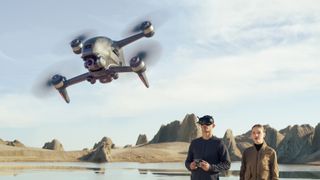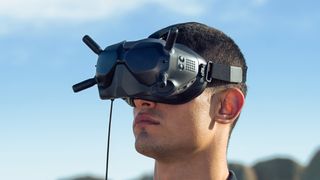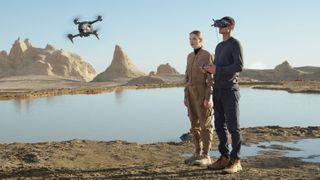
When you purchase through links on our site, we may earn an affiliate commission. Here’s how it works.

The launch of the exciting DJI FPV drone answered the questions posed by its rumors, but also raised some new ones about drone laws – where and how are you actually allowed to fly it?
The confusion stems from the fact that FPV (First Person View) drones are not as simple to fly as standard drones, like the DJI Mavic Air 2, from a safety and legal standpoint.
There's no doubt that FPV flying is an incredibly immersive experience, thanks to the addition of a headset that allows the pilot to see a live video feed from their drone’s forward-facing camera. This means the drone can be flown with a greater degree of precision and accuracy, making it possible to fly them in much more exciting ways than a standard drone.
FPV drones are often also faster than consumer and professional drones, and can perform more extreme aerial maneuvers such as flips and rolls, which is why they’re used for drone racing. But now there’s a new beginner-friendly DJI FPV drone available for the masses, it’s important to know exactly what you should and shouldn’t do with them to keep your flying safe and legal.
FPV goggles can be used with most drones – they’re not exclusive to FPV models – but it’s the use of these headsets to view a live feed of the drone's camera that makes the rules governing their use slightly different.
You can, of course, also use a phone or tablet with an FPV drone rather than a pair of FPV goggles, but even in this situation you’d be closely watching the live camera feed on the screen, so you’ll encounter the same problem of not being able to see the drone in the sky during flight.

When flying any drone, it’s a legal requirement in most regions that you fly no higher than 120m/400ft or a distance of 500m/1640ft, and that the aircraft must remain within unaided visual line of sight (VLOS). This means that you must be able to see your drone in the sky at all times within these parameters, without the use of binoculars or any other visual device.
Sign up for breaking news, reviews, opinion, top tech deals, and more.
By submitting your information you agree to the Terms & Conditions and Privacy Policy and are aged 16 or over.
This presents an immediate problem for FPV drones and their goggles, because the drone pilot is viewing the live camera feed and therefore cannot maintain VLOS. The use of FPV drones and goggles is legal in both the United Kingdom and the United States, but to fly an FPV drone you’ll need an observer who can maintain visual line of sight with the aircraft and communicate this with the pilot.
The rules regarding the use of an observer in the UK and US are practically identical – it’s the exact wording of the rules that differs slightly.
In both countries, when using an FPV drone or FPV goggles, a drone pilot must be assisted by an observer to help them keep the drone away from obstacles and other aircraft.
This observer must keep the drone within unaided visual line of sight (VLOS) at all times and must be standing next to the drone pilot. Remember, this means the observer can't use a screen or binoculars to watch the drone, as the line of sight must be 'unaided'.

You don't need any special qualifications to be an observer, but you must be briefed on what you need to do, and communicate with the pilot to make them aware of any potential risks, so that the pilot can respond accordingly.
There is one exception to all this. If you’re flying an FPV drone in a controlled environment indoors, or within a closed netted structure, where uninvolved people are excluded and the drone cannot escape, an observer isn't required. This kind of situation is typically where drone racing takes place with FPV drones, and is rarely used by the majority of drone pilots.
The rules we’ve looked at so far are specifically for FPV drones or using FPV goggles. But you do, of course, also need to abide by the laws for drones in general – all other drone laws still apply during flights, so you must be aware of these. Fortunately, they're pretty straightforward, whether you're in the US or UK.
In both countries, when flying a drone that weighs 250g or more, you must to register with the FAA in the US and the CAA in the UK. Once you've done that, it's then a case of following the basic rules, which we've laid out below.
Basic US drone laws for leisure flying
 UK drone laws" width="" />
UK drone laws" width="" />
Basic UK drone laws for leisure flying
In short then, the DJI FPV is a slightly more complex proposition than standard drones when it comes to drone laws, but not prohibitively so.
Once you've registered the drone with your region's civil aviation authority, all you'll need to do is grab a well-informed spotter to come on your trip, and follow all the usual laws on flying factors like altitude.
Naturally, the laws on proximity to buildings and people mean that built-up areas are largely off limits and you will have to carefully plan where to go, but the DJI FPV experience promises to be well worth the time and effort. Happy FPV flying.
James Abbott is a professional photographer and freelance photography journalist. He contributes articles about photography, cameras and drones to a wide range of magazines and websites where he applies a wealth of experience to testing the latest photographic tech. James is also the author of ‘The Digital Darkroom: The Definitive Guide to Photo Editing’.